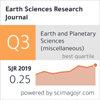Dehaj地型斑岩型铜矿的空间分布及其勘探意义
IF 0.5
4区 地球科学
Q4 GEOSCIENCES, MULTIDISCIPLINARY
引用次数: 0
摘要
岩浆作用是由构造系统触发和控制的,因此这些过程在热液矿物系统的沉积和侵位中发挥着无可辩驳的作用。因此,至关重要的是要认识到与热液矿物系统在遗传学上相关的构造过程。本研究试图通过认识控制伊朗中部德哈杰地区斑岩铜矿分布的主要构造过程来解决这一问题。为此,通过fry、分形和距离分布分析,对31个已知斑岩铜矿床、断层和断裂的空间组合进行了评价。fry分析结果表明,成矿作用沿NE、NW和NS三个不同的走向分布,与该地区的断裂系统有明显的关联。此外,应用的分形方法表明,对矿化的结构控制在两个不同的尺度上运行,即区域尺度和局部尺度。距离分布分析进一步用于评估已知斑岩铜矿床与断层痕迹之间的空间相关性,通过定量测量补充了fry和分形分析的结果。综合这三种方法的结果表明,北西向断裂似乎在区域尺度上控制了岩浆活动;然而,NE向和N向断层可能在局部尺度上控制了含矿流体的通道和侵位。本文章由计算机程序翻译,如有差异,请以英文原文为准。
Spatial distribution of porphyry copper deposits in Dehaj terrain: Implications for exploration
Magmatism is triggered and controlled by tectonic systems, and thus these processes play an irrefutable role in the deposition and emplacement of hydrothermal mineral systems. It is, therefore, paramount to recognize the tectonic processes that are genetically associated with hydrothermal mineral systems. This study seeks to address this caveat by recognizing the main tectonic processes that have controlled the distribution of porphyry copper deposits in Dehaj terrain, Central Iran. For this purpose, the spatial association of 31 known porphyry copper deposits, faults, and fractures were evaluated by fry, fractal, and distance-distribution analyses. The results of fry analysis revealed that mineralization has distributed through three different trends, namely NE, NW, and NS, which shows a clear association with the fault systems presented in the area. Also, the fractal method applied demonstrated that structural controls on mineralization have operated on two different scales, regional and local scales. Distance-Distribution analysis was further used to assess the spatial correlation between known porphyry Cu deposits and fault traces, supplementing the results of fry and fractal analyses by quantitative measurements. The synthesis of the results of these three methods shows that the NW-trending faults have plausibly controlled the magmatism at a regional scale; nevertheless, NE- and N-trending faults have probably operated at local scales controlling the channeling and emplacement of mineral-bearing fluids.
求助全文
通过发布文献求助,成功后即可免费获取论文全文。
去求助
来源期刊

Earth Sciences Research Journal
地学-地球科学综合
CiteScore
1.50
自引率
0.00%
发文量
0
审稿时长
>12 weeks
期刊介绍:
ESRJ publishes the results from technical and scientific research on various disciplines of Earth Sciences and its interactions with several engineering applications.
Works will only be considered if not previously published anywhere else. Manuscripts must contain information derived from scientific research projects or technical developments. The ideas expressed by publishing in ESRJ are the sole responsibility of the authors.
We gladly consider manuscripts in the following subject areas:
-Geophysics: Seismology, Seismic Prospecting, Gravimetric, Magnetic and Electrical methods.
-Geology: Volcanology, Tectonics, Neotectonics, Geomorphology, Geochemistry, Geothermal Energy, ---Glaciology, Ore Geology, Environmental Geology, Geological Hazards.
-Geodesy: Geodynamics, GPS measurements applied to geological and geophysical problems.
-Basic Sciences and Computer Science applied to Geology and Geophysics.
-Meteorology and Atmospheric Sciences.
-Oceanography.
-Planetary Sciences.
-Engineering: Earthquake Engineering and Seismology Engineering, Geological Engineering, Geotechnics.
 求助内容:
求助内容: 应助结果提醒方式:
应助结果提醒方式:


